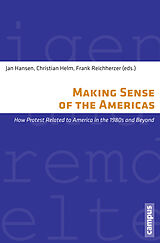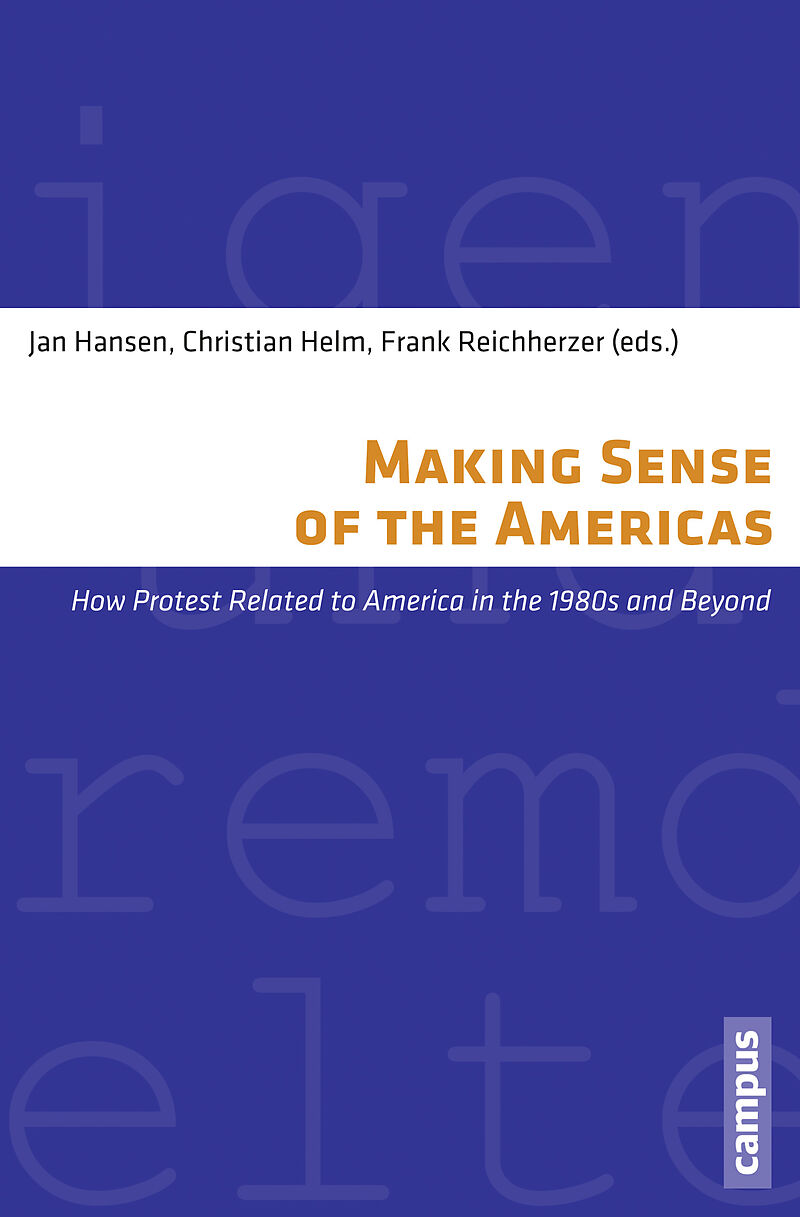Making Sense of the Americas
Einband:
Paperback
EAN:
9783593504803
Untertitel:
How Protest Related to America in the 1980s and Beyond
Genre:
Regional- und Ländergeschichte
Herausgeber:
Campus Verlag GmbH
Auflage:
1. Auflage
Anzahl Seiten:
357
Erscheinungsdatum:
30.11.2015
ISBN:
978-3-593-50480-3
Eigene und Fremde Welten
Herausgegeben von Jörg Baberowski, Stefan Rinke und Michael Wildt
Ob »Sonne statt Reagan« auf der Friedensdemo oder Che-Guevara-Poster und Kaffee aus dem revolutionären Nicaragua in der WG-Küche - die Protestkulturen im Westeuropa der 1980er Jahre speisten sich zu einem Großteil aus der spannungsreichen Auseinandersetzung mit Amerika. Die von ihnen betriebene Sinnstiftung ist also ohne die Bezüge und Referenzen, die Wechselwirkungen und Verflechtungen im »transatlantischen Dreieck« zwischen den beiden Teilen des amerikanischen Kontinents und Europa nicht zu verstehen.
Vorwort
Eigene und Fremde Welten
Herausgegeben von Jörg Baberowski, Stefan Rinke und Michael Wildt
Autorentext
Jan Hansen ist wiss. Mitarbeiter an der HU Berlin. Christian Helm ist wiss. Mitarbeiter an der Universität Hannover. Frank Reichherzer ist wiss. Mitarbeiter am ZMSBw in Potsdam.
Leseprobe
Acknowledgements
The editors would like to express their gratitude to a number of individuals, groups and institutions that contributed and helped in producing this edited volume, which is the result of a workshop held at Humboldt University Berlin in May 2013. First, this conference would not have been possible without the support of Fritz Thyssen Stiftung and the Special Research Unit 640 "Representations of Changing Social Orders". Furthermore, Fritz Thyssen Stiftung approved a generous grant to cover the costs of publication. We are also grateful to Jörg Baberowski, Stefan Rinke and Michael Wildt for their acceptance to include this volume into "Eigene und Fremde Welten". Likewise, we are deeply indebted to Jürgen Hotz, Eva Janetzko and Cornelia Stratthaus of Campus Publishing for their manifold advice and commitment to this edition. Lisa Esser, Kevin Lenk and Julian Nazaruk have offered inestimable support during the editing process.
Jan Hansen, Christian Helm, Frank Reichherzer
August 2015
I. Foundations
Transatlantic Flows and Complex Entanglements of Protest in the 1980s.
An Introduction
Jan Hansen, Christian Helm, Frank Reichherzer
It is 1982. David Horsey, a Pulitzer Prize-winning editorial cartoonist, sketches a world map which he believes will irritate those who look at it. "The World According to Ronald Reagan" is the title of this illustration finally published in the daily newspaper Seattle Post-Intelligencer. Most strikingly, the drawing is not in due proportion to other maps. Basically, it rescales the prevalent view on geography. This may be read as an under-mining of all presumptions about how the world supposedly works. But what can we see when we look at it? First of all, we learn that the world consists of two major countries, namely the United States of America and the Soviet Union, represented by a cowboy figure with the hand on the trigger and a bear-like man with an Ushanka, a Russian-style ear-hat. The cowboy has the face of Ronald Reagan, the then Republican US president, while the bear stands for Leonid Brezhnev, the secretary general of the Soviet Union's communist party. The map further shows the US itself divided into two rivalling parts. On the one hand, there is a giant California with celebrated landmarks such as "Bechtel Corporation", "Hollywood" and "Disneyland", on the other hand there is a remarkably small region called "Democrats and Welfare Bums" on the territory of, roughly, New England. North of the United States the drawing shows "Unexplored Wasteland", south of the country only "Banana Land", disproportionally huge Falkland islands and Cuba as a "Soviet Colony". Europe, quite paradoxically, is almost non-existent, despite Great Britain being "Thatcher-Land". The rest of West Europe is a region of "Socialists and Pacifists" who are opposed to the missiles deployed in this region. While the map describes these missiles as "ours", the USSR has "theirs" just beyond the Iron Curtain - the overall balance is five to six to the disadvantage of the West. At the same time, the African continent, inhabited by "Negroes", seems to be very irrelevant. Twice as big appear the Arab world ("Our Oil") and the state of Israel. The "Palestinian Homeland" is situated somewhere near the North Pole. From an American point of view, however, the biggest enemy stands heavily armed behind the Iron Curtain. His land is almost as huge as the US. Obviously, there is no need to explain how threatening the Russians are. One can read "Godless Communists, Liars and Spies" as the curt portrayal of the red menace.
What then does this map say? "The World according to Ronald Reagan" depicts a binary outlook on international affairs in the early 1980s. It localizes everything that has to be seen as good and worth striving for within the United States and its Republican milieu while similarly demonizing the Soviet Union. Us and them - the map conveys a simple message. Actually, this piece is too simplistic to be taken at face value by readers of the Seattle Post-Intelligencer. The world atlas is a caricature, and Horsey is speaking tongue in cheek. In fact, the map purports to be a clever parody and criticism of the 1980s Republican mindset, but in retrospect we can see that it is not so much an insight into Reagan's world but rather a peek into what his adversaries imagined as Reaganism. As a result, the map serves to illuminate the left-leaning worldview of the time, filtered through parodic lenses. Think of the map as an archaeological document that reveals the structures of how its creators imagined the world.
"The World According to Ronald Reagan" thus functioned as a powerful tool for those who wanted to brand contemporary America. Democrats all over the country received the caricature with enthusiasm. Not only in the United States was the illustration being reprinted again and again. More than that, it evolved into a famous iconic topos of social protest movements against "the establishment" in the Western hemisphere. This is why we choose to begin our book, which is about how protest activists represented "the Americas" in the 1980s, by talking about this figure. In sum, "The World According to Ronald Reagan" has to do with three things: first, a Manichean view ascribed to Reagan by the protesters, which appears to be at least ignorant or even dangerous; second, the differentiation between an outsized North America and a marginalized southern part; and third, the style element of parody as the dominant means of expression. These three principles - Cold War binarity, the two differing Americas and irony as a stylistic device in voicing protest - can help us to analyze the images with which the 1980s protest activists constructed their world. This is what this book is all about.
To begin with, it is necessary to underline that the terms "establishment" and "protesters", widely used in this book, are contemporary to the time we are dealing with. One has to bear in mind how these concepts served as vehicles in shaping a specific representation of the other. This is why we need to historicize how the people of the 1980s used to categorize each other. To put it in a nutshell, those who condemned official politics were classified as protesters by the object of their criticism - and not by themselves. The "establishment" then vice versa is the term coined by the 1968 students for the government, the police or the courts. Labelling, from a historical point of view, is a matter of ascribing legitimacy. The terms "protesters" and "establishment" undermined the respective cause of the opponent for both the discontented citizens and the representatives of the state. Bearing in mind how powerful language can be for the construction of reality, we have to concede that we can barely escape this process. It is against this backdrop that we, the editors of this book, use the terms "protesters" and "establish…

Leider konnten wir für diesen Artikel keine Preise ermitteln ...
billigbuch.ch sucht jetzt für Sie die besten Angebote ...
Die aktuellen Verkaufspreise von 6 Onlineshops werden in Realtime abgefragt.
Sie können das gewünschte Produkt anschliessend direkt beim Anbieter Ihrer Wahl bestellen.
Loading...
Die aktuellen Verkaufspreise von 6 Onlineshops werden in Realtime abgefragt.
Sie können das gewünschte Produkt anschliessend direkt beim Anbieter Ihrer Wahl bestellen.
| # | Onlineshop | Preis CHF | Versand CHF | Total CHF | ||
|---|---|---|---|---|---|---|
| 1 | Seller | 0.00 | 0.00 | 0.00 |
